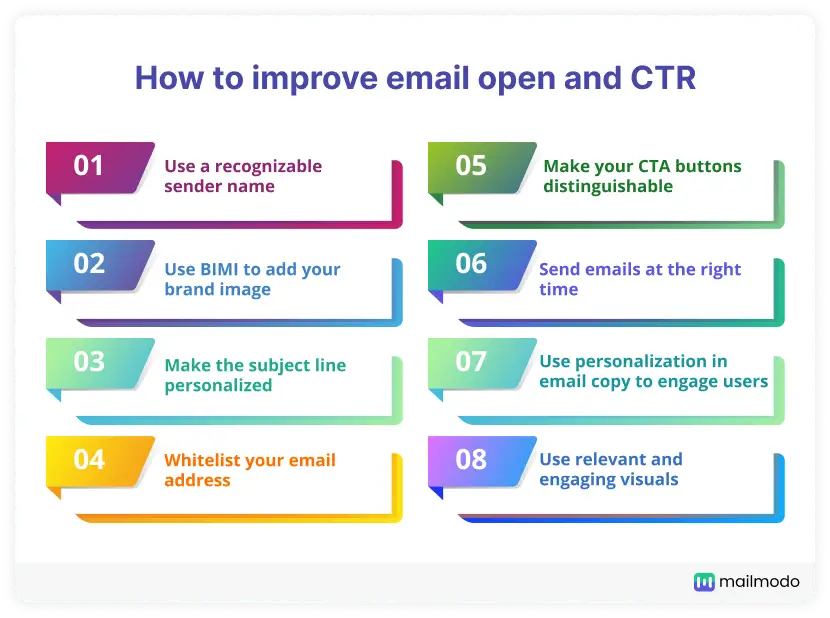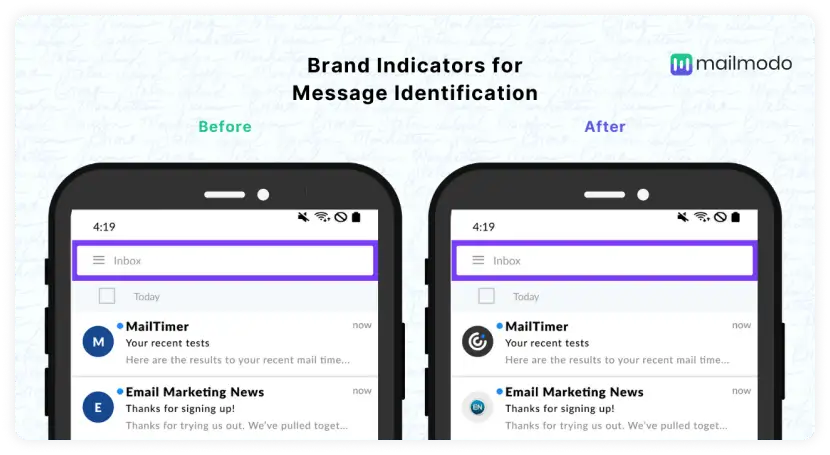As an email marketer, you should know the engagement level of your subscriber with your email campaigns. You can track these two email metrics - email open rates and click-through rate (CTR).
This guide will discuss how to calculate open rates and CTR, average industry benchmarks, and tips to improve these metrics to enhance the performance of your email campaigns.
Table of contents
How to improve open rates and CTR
- 1. Use a recognizable sender name
- 2. Use BIMI to add your brand image
- 3. Make the subject line personalized
- 4. Whitelist your email address
- 5. Make your CTA buttons distinguishable
- 6. Send emails at the right time
- 7. Use personalization in email copy to engage users
- 8. Use relevant and engaging visuals
- 9. A/B test your emails
What is the email open rate?
Email open rate is the proportion of emails opened out of total emails delivered. It shows the effectiveness of your subject line and engagement.
How to calculate the email open rate?
You can calculate the open rate using this formula:
Open rate = ( Number of people who have opened your email / Number of emails delivered) X 100.
If you sent 5000 emails and out of these, 4000 got delivered, and 2000 emails were opened, your email opens would be ( 2000 / 4000 ) X 100 = 50%
What is the email click-through rate?
The email click-through rate is the proportion of people or subscribers who click on a particular link out of the total emails delivered.
How to calculate the email click-through rate
Click-through rate formula = ( Number of people who have clicked on a link / Number of emails delivered) X 100
If out of 4000 delivered emails total clicks you got are 800, the click-through rate would be 10%.
Here we would like to distinguish click-through rate (CTR) from click to open rate (CTOR). Both these metrics are often confused, but there is a subtle difference.
While click-through rate measures the clicks out of total emails delivered, click-to-open measures the clicks out of total emails opened.
To know in detail, you can check out our guide CTOR vs. CTR – Which Metric You Should Track
Why should you track email open rates and CTR?
There are many benefits to measuring and tracking these rates. The most important are as follows:
Open rates offer insight into the effectiveness of your email subject line.
With CTR, you can assess whether your content engages the reader.
You can also track where users click the most as they open your emails.
Offers insights into your sending frequency.
All this information can be used to draw actionable steps to work on the loopholes and optimize your email and subject line for higher conversions.
For example, your open rate will fall if you send too many emails because you are a crowded recipient already crossed your inbox with emails they might not want to receive. Through these insights, you can test out your sending frequency and analyze the result.
Related guide: 6 Effective Tips To Boost Your Email Conversion Rate in 2022
What is a good open rate and click-through rate?
The average open and click-through rates vary depending on the industry, email campaign type, geographical location, and related factors.
But, some research offers insights into the average email open and click-through rates. Here's a summary of some of the reliable data:
| Companies | Average email open rate | Average email CTR\ |
|---|---|---|
| Mailchimp | 21.33% | 2.62% |
| DMA 2021 | 28.0% | 3.8% |
| Netcore 2020 | 10.28% | 0.5% |
| CampaignMonitor 2021 | 18% | 2.6% |
As per the above data, a good email open rate would be 15-20%. Therefore, the good email click-through rate is approximately 2.5%.

Note: The methodology and surveyed audience might vary, and we recommend you check out these reports before applying these standards to your email campaigns' performance.
How to improve open rates and CTR

Here are a few effective ways to skyrocket your email click-throughs and open rate:
1. Use a recognizable sender name
Pathwire's report states that 88.7% of respondents say recognizing the sender is important in determining whether to open an email. A brand or recognizable name builds trust and helps recipients associate an email with someone they know. It increases the chances of getting more open.
Look at some of the good sender names we found in our inbox. 👇🏼

2. Use BIMI to add your brand image
According to the DMA Consumer Market Tracker 2021, 68% of individuals say brand recognition is an important factor in deciding whether to open an email or not.
One of the best ways to build brand recognition is to add your brand logo next to your email with BIMI. Brand Indicators for Message Identification (BIMI) is a standard that allows you to add a logo next to your emails once it's set up properly.
BIMI looks like this in a user's inbox 👇🏼

Check out our complete guide on BIMI.
3. Make the subject line personalized
The subject line directly impacts your open rate as after the sender name, it's the first thing that recipients see to decide whether an email is worth their time or not. It's your best chance to make a great first impression and stand out in the recipient's crowded inbox.
To get more opens and clicks, try to make your subject lines personalized, as 43.6% of people would open emails that seem personalized or relevant to their interest. - Pathwire inbox report 2021.
To know how to craft a subject line that hooks readers and gets higher open and clicks, check out our subject line ebook.
4. Whitelist your email address
One way to ensure you land in a user's inbox and get more opens is to whitelist your email address. You can instruct subscribers to move your emails to their primary inbox as it signals ISPs that your emails come from a legitimate domain and are relevant. Read how SBNRI maintained their email list hygiene with Mailmodo, leading to a 16% increase in open rates.
5. Make your CTA buttons distinguishable
To compel users to click on your CTA links or buttons, you need to give them a reason to do so. Users should know what they can expect when they click on that link to your email copy needs to be descriptive, clear, and targeted.
Besides, there are other best practices you should follow:
Adding enough white space around CTA elements will make it for recipients to click.
Make your CTA button or links bigger
Underline or bold them to make them stand out
Use visual cues like arches, arrows, or emojis to direct users toward that button.
6. Send emails at the right time
The chances of getting more open and engaged are higher when users actively check their emails. You should analyze your subscriber's behavior and engagement to assess the best timing to send different email campaigns.
Check out our best time to send emails guide to know the industry benchmarks.
7. Use personalization in email copy to engage users
Along with the subject line, you should also make the email copy personalized to make it more personal and relevant to the recipient. There are different parameters to add personalization apart from the first name, including:
Past purchasing behavior
Geographical location
Use personalized images
Related guide: An Ultimate Guide to Creating Personalized Emails
8. Use relevant and engaging visuals
Visuals like images, GIFs, or illustrations make email more engaging by giving users something to look at rather than read. A text-heavy email might bore readers and increase the mental load to process the information. Visuals can help reduce that mental load and create a more engaging experience by giving something different.
Here's an example of engaging visuals + interactive gamified elements in an email 👇🏼
Check out more such interactive AMP email templates
9. A/B test your emails
Without testing, you can guess what's working and not, and it might be nothing less than gambling your investment away. To make reliable decisions, you should A/B test your subject line and elements of email copy such as CTA buttons, images, layout, etc.
By showing variations of your subject line or email CTA button, you can get insights into what your audience likes the most instead of implying what you think they'll like. The more you test, the more data you'll have to make changes and optimize different email elements for higher opens and clicks.
Read more about conducting A/B tests on your emails.
Takeaways
A high email open and CTR give insights into your campaign's performance. Still, these insights won't be fruitful if you're not combining them with other email metrics, CTOR, and conversions.
Tracking the overall engagement rate of your subscribers is essential to keep creating useful content and sending them the most relevant emails. That way, you can create a holistic view of your campaign's performance, see improved email metrics, and drive higher ROI.
What you should do next
Hey there, thanks for reading till the end. Here are 3 ways we can help you grow your business:
Talk to an email expert. Need someone to take your email marketing to the next level? Mailmodo’s experts are here for you. Schedule a 30-minute email consultation. Don’t worry, it’s on the house. Book a meet here.
Send emails that bring higher conversions. Mailmodo is an ESP that helps you to create and send app-like interactive emails with forms, carts, calendars, games, and other widgets for higher conversions. Get started for free.
Get smarter with our email resources. Explore all our knowledge base here and learn about email marketing, marketing strategies, best practices, growth hacks, case studies, templates, and more. Access guides here.


